Description
The Arduino Uno is a popular microcontroller board based on the ATmega328P microcontroller. It is a part of the Arduino hardware platform, which is widely used in the maker and electronics communities for prototyping and creating various projects. Here are some key features of the Arduino Uno:
- Microcontroller: The Arduino Uno is built around the ATmega328P microcontroller, which is an 8-bit AVR microcontroller. This microcontroller has flash memory for storing your program, SRAM for variables, and EEPROM for non-volatile storage.
- Digital and Analog I/O: The Arduino Uno has 14 digital input/output (I/O) pins, of which 6 can be used as PWM (Pulse Width Modulation) outputs. Additionally, it has 6 analog input pins.
- Clock Speed: The ATmega328P on the Arduino Uno runs at 16 MHz.
- USB Interface: The Arduino Uno can be connected to a computer via a USB-B cable. This allows you to upload your code to the board and communicate with it.
- Power Supply: The Arduino Uno can be powered via the USB connection or an external power supply. It can accept a voltage input ranging from 7 to 12 volts.
- Voltage Regulator: The board includes a voltage regulator that provides a stable 5V supply to the microcontroller and other components on the board.
- Reset Button: There is a reset button on the board that restarts the microcontroller.
- LEDs: The board has built-in LEDs, including a power indicator, a built-in LED on pin 13, and LEDs for indicating data transmission over USB.
- ICSP Header: The In-Circuit Serial Programming (ICSP) header allows you to program the Arduino Uno using an external programmer.
- Open Source: Arduino is an open-source platform, which means that the hardware and software designs are open for anyone to use and modify. This has contributed to its popularity and widespread adoption.



Reviews
There are no reviews yet.